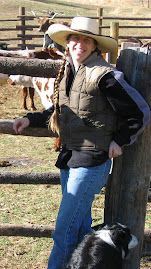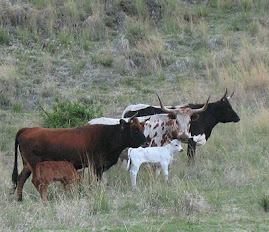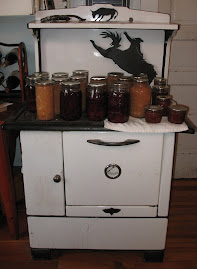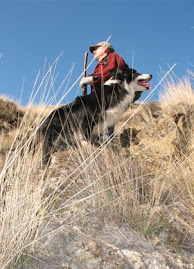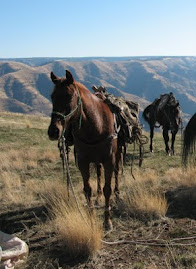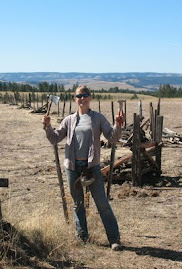Today I was reminded of a tried and true companion that has travelled with me from the Okanogan to the Yukon to Hells Canyon and the Wallowa Valley. I’m talking about The Herb Book by John Lust. The subject of the book came up over dinner when we were discussing a malady that has afflicted me the last few weeks, the nasty rash, swelling and pain caused by exposure to Rhus radicans L, poison ivy.
Since I have been affected before, I know what poison ivy (commonly referred to in these parts as poison oak) looks like and I avoid it like the plague. But I still get it several times a year, from Mike, the dogs, tools, laundry, etc. This time I suspect I got it from the horses. When Mike and our good friend Bryan trailed the cows up Log Creek to the summer range, they said they went through a “jungle” of poison oak. I remembered not to touch the dogs, but I forgot about the horses.
The Herb Book contains a startling amount of information on useful plants. It not only includes botanical information, but also educates the reader on medicinal terminology, methods of preparation, nutritional properties, other useful properties, herbal formulas, plant lore and has several comprehensive indexes. Yellowed and worn, I grabbed the compact and dense paperback from my kitchen cupboard and showed it to my friend at the dinner table. “Wow,” she said, “I’ve never used a book enough to have it look like this.”
That’s when I realized how many times this book has helped me treat various illnesses, wounds and discomforts for myself and my family. Living in remote areas, I could often use this resource to find herbal relief in my cupboard, garden, or surrounding landscape. Just a few days ago, I used it to review the properties of my chosen remedy for poison oak and refresh my memory on preparation, dosage and application.
I have heard of many “treatments” for poison oak, everything from bleach and kerosene, to scratching-the-heck-out-of-it, to steroids and shots of whiskey. The remedy I prefer is a decoction of black walnut leaves. Luckily, Mike was heading down river so he picked some fresh leaves for me. As a plant person recently reminded me, the treatment for offensive plants is generally another plant that grows in the same region.
In this case, I used two remedies.
Black Walnut Poison Oak Remedy
Simmer a couple cups of whole fresh leaves in about a quart of water for 5 - 10 minutes. (Dry leaves can be substituted for fresh, simmer 10 minutes.) Let cool. Pour leaves and decoction into a glass jar and store in the fridge. If you are not going to use it up in a week or so, strain and discard the leaves before storing the liquid. Soak a small cloth in the liquid and apply it to the affected area for several minutes, three or four times a day. It helps relieve itching and dry out the rash.
The Other “Remedy”
I hiked from Buckhorn Springs out the end of the ridge above Tulley Creek. A storm was gathering, with fretful winds, dull yellow underbellies of thunderheads, and dark curtains of rain trailing south. When I reached a rock knob at the end of the ridge, I looked down to the Tulley Creek bench below, and the spot where our first home in Wallowa County still squats beside the creek in a ribbon of birch, alder, and willow.
I sat down to contemplate the vast expanse before me and suddenly the world was becalmed. Not a breath of wind, not a bird singing, not even a fly buzzing. It was utterly still. The kind of quiet you can feel on your skin.
Now that kind of remedy works for most anything.
Wednesday, July 29, 2009
Saturday, July 25, 2009
Prairie Terroir
Luckily there was a breeze on the Zumwalt today. It’s hot. It’s July. Out in the open, where the sun is baking the range, there’s the pungent smell of tarweed and yarrow. I like that smell.
This morning Mike dropped me off at the pond and I hiked the upper fence, checking for holes where the elk wander through on their daily travels. I climbed above the head of Alder Creek and crossed a swath of biscuit-scab terrain, the interesting mounds of vegetated soil with rocky bare channels between. Nobody knows for sure what resulted in this unique rangeland feature, some say glaciers, others geologic floods, and once I even heard a theory about giant prehistoric gophers!
In spite of the dryness, there were still wildflowers: pink buckwheat, lilac erigeron, magenta dianthus, purple-blue penstomon. I followed the fence off the top down into a stand of Ponderosa Pine, thankful for the shade. In the dappled shadows, the grass was green and lush, with birds flitting and calling among the trees and shrubs. I swear I could smell the huckleberries ripening, even though I couldn’t find any.
Every time I look up into a big old Ponderosa Pine, I think of cougars. I think of how a cougar can jump almost twenty feet straight up, easy as pie. I look at those massive tree limbs arching out from the trunk and I think to myself, “If I were a cougar I’d hop up there, drape myself along that branch and take a nap.”
No cougars today, but lots of birds and butterflies and our cow herd happily wandering the range, enjoying the breeze just like me. Out in the open, I was reminded how beastly hot it gets on the Zumwalt, how when we lived at the Steen Place the kids would try and swim in Chesnimnus Creek even though it hardly had any water in it. They wandered along the creek bed looking for holes deep enough to wallow in and came back to the house covered in mud. I had to pump a couple buckets from the well and douse them off before I could let them in.
The Steen Place is a big two story hundred year old log house at the edge of the prairie. We summered there off and on over the years, and we have many memories of good times and hard work with the folks who cowboyed together there. It seemed we always had some project going to try to fix up the house. One spring the pack rats packed 50 pounds of dog food, one piece at a time, from the front porch up into the attic where it collapsed the ceiling and fell through into the bedroom below. We got new sheetrock on the ceiling that summer. When the ranch sold recently, people stopped living there. I wonder if it will ever be cared for as anyone’s home again.
The Steen Place is just one more reason why I love this country. The open rolling grassland, the mosaic of timber, the deep red canyons, the wide benchlands, the lush dynamic river bottoms. Like the grass and the cattle, we have become the product of its soil, climate and culture. This is our terroir.
This morning Mike dropped me off at the pond and I hiked the upper fence, checking for holes where the elk wander through on their daily travels. I climbed above the head of Alder Creek and crossed a swath of biscuit-scab terrain, the interesting mounds of vegetated soil with rocky bare channels between. Nobody knows for sure what resulted in this unique rangeland feature, some say glaciers, others geologic floods, and once I even heard a theory about giant prehistoric gophers!
In spite of the dryness, there were still wildflowers: pink buckwheat, lilac erigeron, magenta dianthus, purple-blue penstomon. I followed the fence off the top down into a stand of Ponderosa Pine, thankful for the shade. In the dappled shadows, the grass was green and lush, with birds flitting and calling among the trees and shrubs. I swear I could smell the huckleberries ripening, even though I couldn’t find any.
Every time I look up into a big old Ponderosa Pine, I think of cougars. I think of how a cougar can jump almost twenty feet straight up, easy as pie. I look at those massive tree limbs arching out from the trunk and I think to myself, “If I were a cougar I’d hop up there, drape myself along that branch and take a nap.”
No cougars today, but lots of birds and butterflies and our cow herd happily wandering the range, enjoying the breeze just like me. Out in the open, I was reminded how beastly hot it gets on the Zumwalt, how when we lived at the Steen Place the kids would try and swim in Chesnimnus Creek even though it hardly had any water in it. They wandered along the creek bed looking for holes deep enough to wallow in and came back to the house covered in mud. I had to pump a couple buckets from the well and douse them off before I could let them in.
The Steen Place is a big two story hundred year old log house at the edge of the prairie. We summered there off and on over the years, and we have many memories of good times and hard work with the folks who cowboyed together there. It seemed we always had some project going to try to fix up the house. One spring the pack rats packed 50 pounds of dog food, one piece at a time, from the front porch up into the attic where it collapsed the ceiling and fell through into the bedroom below. We got new sheetrock on the ceiling that summer. When the ranch sold recently, people stopped living there. I wonder if it will ever be cared for as anyone’s home again.
The Steen Place is just one more reason why I love this country. The open rolling grassland, the mosaic of timber, the deep red canyons, the wide benchlands, the lush dynamic river bottoms. Like the grass and the cattle, we have become the product of its soil, climate and culture. This is our terroir.
Saturday, July 18, 2009
Velvet and Luminous
In his collection Elemental Odes, Chilean poet Pablo Neruda has written some of the most sensuous love poems in history. Consider this excerpt from Ode to the Onion:
In the garden, the earth heaped up her power showing your naked transparency and as the remote sea in lifting the breasts of Aprhodite duplicated the magnolia, so did the earth make you.
Yes, one can write a love poem about a vegetable or a fruit.
Like the intoxicating and voluptuous apricot. Three pickings already this week and now they are dozing in boxes in the basement, ripening, ripening.
Evenings I break a sweat carving their little orbs into the makings of luminescent preserves, racks loaded for the fruit dryer and quarts of perfect halves floating in their exquisite nectar.
Poet and professor David Wagoner talks about feeling like he was using the same words over and over in his poems. When he examined his work, he found the six words that his poetry lived on: wind, bird, tree, water, grass, and light.
Apricot is one of my words.
I feel a sense of embarrassment every time the apricot appears in another of my poems, but I can’t help it. Sometimes they just sneak in there. And this is definately one of those moments. They are such a gift.
Canyon Apricots
And come the long baked days of summer
I return for the harvest glowing
among the fluttering leaves. Velvet
shoulders gently plucked from stems,
and lolling in my palm, the succulence
of blushing cheek and silken cleft.
Again my lips reach for tender skin
the burst of flesh, sweet quenching
I can not swallow enough of.
And all this for simply needing and finding
what was left by those before us
hidden here among the rims and benches.
In the garden, the earth heaped up her power showing your naked transparency and as the remote sea in lifting the breasts of Aprhodite duplicated the magnolia, so did the earth make you.
Yes, one can write a love poem about a vegetable or a fruit.
Like the intoxicating and voluptuous apricot. Three pickings already this week and now they are dozing in boxes in the basement, ripening, ripening.
Evenings I break a sweat carving their little orbs into the makings of luminescent preserves, racks loaded for the fruit dryer and quarts of perfect halves floating in their exquisite nectar.
Poet and professor David Wagoner talks about feeling like he was using the same words over and over in his poems. When he examined his work, he found the six words that his poetry lived on: wind, bird, tree, water, grass, and light.
Apricot is one of my words.
I feel a sense of embarrassment every time the apricot appears in another of my poems, but I can’t help it. Sometimes they just sneak in there. And this is definately one of those moments. They are such a gift.
Canyon Apricots
And come the long baked days of summer
I return for the harvest glowing
among the fluttering leaves. Velvet
shoulders gently plucked from stems,
and lolling in my palm, the succulence
of blushing cheek and silken cleft.
Again my lips reach for tender skin
the burst of flesh, sweet quenching
I can not swallow enough of.
And all this for simply needing and finding
what was left by those before us
hidden here among the rims and benches.
Tuesday, July 7, 2009
Little Houses and Lasting Partnerships
The Bunkhouse Orchestra has a song about the "little house that stands among the trees" and they are not talking about a cottage.
We have built, restored and reholed many an outhouse over the years. I have great respect for a good outhouse and there are definitely times when two holes are better than one. Some of my favorites are the two holers that have a regular size hole for grown-ups and a stepped down hole for the kids.
When the 1,000 year flood came in 1997, we lassoed the privy at Corral Creek and tied it off to a tree. It survived, upright in the raging floodwaters, riding the waves like some kind of ark.
At Horse Creek our centennial one-holer is made out of hand split tamarack planks and square nails which date to a hundred years ago. It was in pieces when we found it. Mike carefully dismantled them and is now restoring it to a place of honor just up the hill from the ranch house.
The old farmhouse we live in has both an indoor flush version and an outdoor one-holer. We tell guests that when they stay in the bunkhouse it comes with its own privy. In fact, it has a dutch door so you can enjoy your privacy and the view of the mountains at the same time.
Indoors, the flush facility has its own character. It is lilac. Lilac sink, lilac tub and yes, lilac toilet. This was Hattie Freudenberg's house and purple was her favorite color. In June, the toilet perfectly matches the immense hedge of lilacs blooming all along the front of the yard.
Mike spent quite a bit of his 4th of July holiday removing and refurbishing said toilet. After seventy years you can expect a piece of plumbing to have a few issues. Which reminds me how thankful I am for lasting partnerships and division of labor. While I have fixed many a toilet, I'd much rather spend my time making a pie for him to enjoy when he is done with the plumbing job. It is not likely we'll find another lilac toilet, so we are trying to make this one last. But we'll always have the little house out back, just in case.
Ode to the Privy
Four walls and a door, with a roof overhead
one hole or two, not much more than a shed
but you never freeze shut, you never break down
a sure sign that we are not living in town.
O outhouse dear outhouse you welcome us in
when wind rattles by and rain hits the tin
so we'll sweep out the spiders and shovel your snow
because whenever we need you, you're ready to go.
We have built, restored and reholed many an outhouse over the years. I have great respect for a good outhouse and there are definitely times when two holes are better than one. Some of my favorites are the two holers that have a regular size hole for grown-ups and a stepped down hole for the kids.
When the 1,000 year flood came in 1997, we lassoed the privy at Corral Creek and tied it off to a tree. It survived, upright in the raging floodwaters, riding the waves like some kind of ark.
At Horse Creek our centennial one-holer is made out of hand split tamarack planks and square nails which date to a hundred years ago. It was in pieces when we found it. Mike carefully dismantled them and is now restoring it to a place of honor just up the hill from the ranch house.
The old farmhouse we live in has both an indoor flush version and an outdoor one-holer. We tell guests that when they stay in the bunkhouse it comes with its own privy. In fact, it has a dutch door so you can enjoy your privacy and the view of the mountains at the same time.
Indoors, the flush facility has its own character. It is lilac. Lilac sink, lilac tub and yes, lilac toilet. This was Hattie Freudenberg's house and purple was her favorite color. In June, the toilet perfectly matches the immense hedge of lilacs blooming all along the front of the yard.
Mike spent quite a bit of his 4th of July holiday removing and refurbishing said toilet. After seventy years you can expect a piece of plumbing to have a few issues. Which reminds me how thankful I am for lasting partnerships and division of labor. While I have fixed many a toilet, I'd much rather spend my time making a pie for him to enjoy when he is done with the plumbing job. It is not likely we'll find another lilac toilet, so we are trying to make this one last. But we'll always have the little house out back, just in case.
Ode to the Privy
Four walls and a door, with a roof overhead
one hole or two, not much more than a shed
but you never freeze shut, you never break down
a sure sign that we are not living in town.
O outhouse dear outhouse you welcome us in
when wind rattles by and rain hits the tin
so we'll sweep out the spiders and shovel your snow
because whenever we need you, you're ready to go.
Friday, July 3, 2009
A Sam Loftus Kind of Day
Today the bulls get a surprise. They are going to the prairie to be reunited with the cow herd. At this moment, they are lounging in the shade of the willow trees out by the corral, their bellies full of lush green valley pasture grass. It is a pretty good day already, but it’s going to get better and they don’t even know it.
Mike could get a surprise today too. I made a super delicious sour cream fudge cake late last night and now I’m picturing a picnic to surround that cake, on the breaks of the canyon, overlooking the deep-cut tributaries of the lower Imnaha River. It could be a Sam Loftus memorial kind of day.
Sam was our first cow boss when we came into Hells Canyon nearly thirty years ago. I remember the first time I met him. We had recently moved into the cow camp at Tully Creek, a long ways from anybody and five miles up a dirt driveway that was ten miles down a cliff-hanging dirt road. The cabin was well worn, with a rich history of pioneering souls and packrat invasions, an unreliable spring, and an equally unreliable toilet that somebody had installed on the front porch.
It was early in the morning on a wet April day and I was trying to get a garden plot started below the cabin. I had two kids under the age of two and Mike had already left for the day’s work, so I snuck out while the kids were sleeping. The view out across the wide canyon benches at Tully Creek was stark and soothing. It’s one of those rare open places in what is otherwise an up and down landscape.
As I squatted in the damp dirt among my scraggly beds of seedlings, I suddenly heard the thump of hooves and the hard breath of a horse climbing the draw. I turned and stood as an older cowboy galloped up on a huge dapple grey gelding that he slid to a stop practically on top of me. “Where’s your man?” he barked, towering over me while his horse blew, spraying me with slobber. “What are you doing out here? You’ll never get a garden to grow. Too hot and not enough water.”
His orneriness could have been intimidating, except for his impish grin and his eyes that twinkled out from under the brim of his hat. I knew there was a sense of humor under his loud, bossy demeanor and I knew I had to be just as tough as he was if we were going to get along.
Sam’s been gone a couple years now and the memories of all the seasons and places we worked together fill most of my life so far. The big ancient log summer house at the Steen Place, the tiny winter cabin at the Litch Place, Indian Village, School Flat, Vance Knoll, Square Mountain. And even when we weren’t working for Sam, we still relied on his knowledge of where to trail from one range to another, where to water, how to deal with a sick animal.
One of the last pictures I have of Sam is at Buckhorn. He’s sitting in a wheel chair at the edge of the fire look-out. The breaks of the canyon fall away right behind him, where he looks down at the trail from summer to winter range. And over his shoulder are the dusky clefts of the drainages, Horse Creek, Lighting, Cow, Corral, Thorn, Tulley. And on the horizon, the high red hogback ridges, Haas, Grizzly, Windy, Summit.
So that’s what I’m thinking. A picnic at Buckhorn after we drop off the bulls. A few good stories, some of that awesome chocolate cake, and a look into the canyon that has shaped our work, our lives and our friendships all these years.
Mike could get a surprise today too. I made a super delicious sour cream fudge cake late last night and now I’m picturing a picnic to surround that cake, on the breaks of the canyon, overlooking the deep-cut tributaries of the lower Imnaha River. It could be a Sam Loftus memorial kind of day.
Sam was our first cow boss when we came into Hells Canyon nearly thirty years ago. I remember the first time I met him. We had recently moved into the cow camp at Tully Creek, a long ways from anybody and five miles up a dirt driveway that was ten miles down a cliff-hanging dirt road. The cabin was well worn, with a rich history of pioneering souls and packrat invasions, an unreliable spring, and an equally unreliable toilet that somebody had installed on the front porch.
It was early in the morning on a wet April day and I was trying to get a garden plot started below the cabin. I had two kids under the age of two and Mike had already left for the day’s work, so I snuck out while the kids were sleeping. The view out across the wide canyon benches at Tully Creek was stark and soothing. It’s one of those rare open places in what is otherwise an up and down landscape.
As I squatted in the damp dirt among my scraggly beds of seedlings, I suddenly heard the thump of hooves and the hard breath of a horse climbing the draw. I turned and stood as an older cowboy galloped up on a huge dapple grey gelding that he slid to a stop practically on top of me. “Where’s your man?” he barked, towering over me while his horse blew, spraying me with slobber. “What are you doing out here? You’ll never get a garden to grow. Too hot and not enough water.”
His orneriness could have been intimidating, except for his impish grin and his eyes that twinkled out from under the brim of his hat. I knew there was a sense of humor under his loud, bossy demeanor and I knew I had to be just as tough as he was if we were going to get along.
Sam’s been gone a couple years now and the memories of all the seasons and places we worked together fill most of my life so far. The big ancient log summer house at the Steen Place, the tiny winter cabin at the Litch Place, Indian Village, School Flat, Vance Knoll, Square Mountain. And even when we weren’t working for Sam, we still relied on his knowledge of where to trail from one range to another, where to water, how to deal with a sick animal.
One of the last pictures I have of Sam is at Buckhorn. He’s sitting in a wheel chair at the edge of the fire look-out. The breaks of the canyon fall away right behind him, where he looks down at the trail from summer to winter range. And over his shoulder are the dusky clefts of the drainages, Horse Creek, Lighting, Cow, Corral, Thorn, Tulley. And on the horizon, the high red hogback ridges, Haas, Grizzly, Windy, Summit.
So that’s what I’m thinking. A picnic at Buckhorn after we drop off the bulls. A few good stories, some of that awesome chocolate cake, and a look into the canyon that has shaped our work, our lives and our friendships all these years.
Subscribe to:
Comments (Atom)


